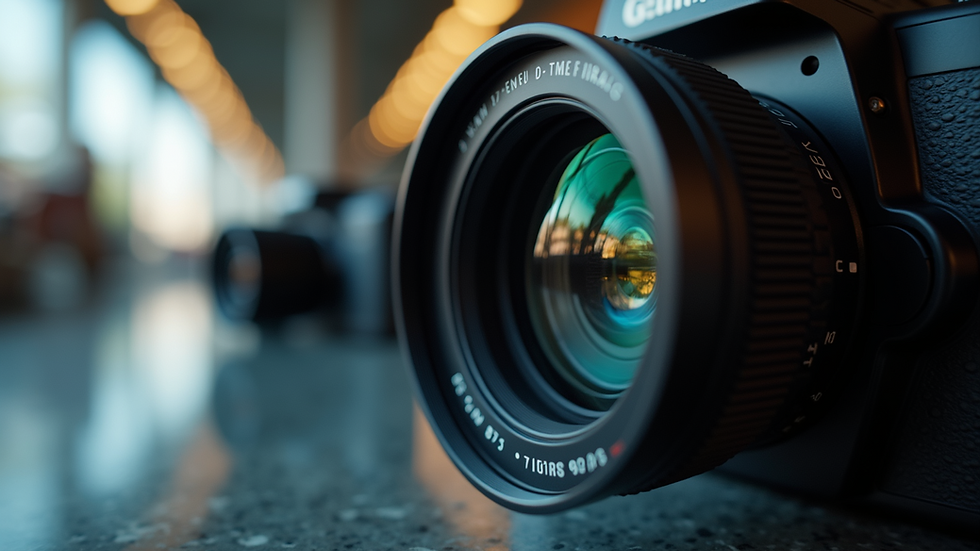How to Choose the Best Camera for Your Photography Needs
- gear4greatness
- 3 days ago
- 4 min read
Choosing the right camera can be overwhelming with so many options available today. Whether you are a beginner or an experienced photographer, understanding your needs and the features of different cameras is essential. This guide will help you navigate the camera market and make an informed decision that suits your photography style and budget.
Understanding Your Photography Needs - Camera Comparison Basics
Before diving into camera specifications, it is important to identify what kind of photography you want to pursue. Different cameras excel in different areas such as landscape, portrait, sports, or wildlife photography. Here are some key factors to consider:
Purpose: Are you shooting portraits, landscapes, action, or video? Each genre may require different camera features.
Skill Level: Beginners might prefer user-friendly cameras with automatic modes, while professionals may want full manual control.
Budget: Cameras range from affordable point-and-shoots to high-end professional models.
Portability: Consider the size and weight if you plan to travel or shoot on the go.
Lens Compatibility: Some cameras have a wide range of lenses available, which can be important for future upgrades.
For example, if you enjoy travel photography, a lightweight mirrorless camera with good image stabilization might be ideal. On the other hand, sports photographers often need fast autofocus and high frame rates.

Key Features to Compare When Choosing a Camera
When comparing cameras, focus on these essential features to find the best fit:
Sensor Size and Resolution
Full-frame sensors offer better image quality and low-light performance but tend to be more expensive.
APS-C sensors are smaller but still provide excellent quality for most uses.
Megapixels matter for large prints or cropping but are not the only indicator of quality.
Autofocus System
A fast and accurate autofocus system is crucial, especially for action or wildlife photography. Look for cameras with multiple autofocus points and advanced tracking capabilities.
Image Stabilization
Built-in image stabilization helps reduce blur from hand shake, which is useful for handheld shooting and video.
Video Capabilities
If you plan to shoot video, check the camera’s resolution (4K, 1080p), frame rates, and microphone input options.
Battery Life
Long battery life is important for extended shoots or travel.
Connectivity
Wi-Fi, Bluetooth, and app compatibility can simplify transferring photos and remote control.
Build Quality and Weather Sealing
Durability and weather resistance are important if you shoot outdoors or in challenging conditions.
By comparing these features, you can narrow down your choices to cameras that meet your specific needs.

Is the Nikon Z6III better than the Sony A7IV?
The Nikon Z6III and Sony A7IV are two popular full-frame mirrorless cameras that appeal to enthusiasts and professionals alike. Here’s a detailed comparison to help you decide which might be better for your photography needs.
Image Quality and Sensor
Both cameras feature 24-26 megapixel full-frame sensors delivering excellent image quality. The Sony A7IV has a slight edge in resolution with 33MP, offering more detail for cropping and large prints.
Autofocus and Performance
Sony’s autofocus system is renowned for its speed and accuracy, with 759 phase-detection points and real-time eye autofocus for humans and animals. Nikon’s Z6III also offers impressive autofocus with 273 points and good subject tracking but is generally considered a step behind Sony in this area.
Video Features
The Sony A7IV supports 4K video at up to 60fps and offers advanced video tools, making it a favorite among hybrid shooters. The Nikon Z6III also shoots 4K but maxes out at 30fps, which might be limiting for some videographers.
Build and Handling
Both cameras have robust builds with weather sealing. Nikon’s ergonomics are praised for comfort, while Sony’s compact design appeals to those prioritizing portability.
Battery Life
Nikon Z6III offers slightly better battery life, which can be important for long shoots.
Lens Ecosystem
Sony has a more extensive native lens lineup and third-party support, giving it an advantage for future upgrades.
In summary, if autofocus and video are priorities, the Sony A7IV may be the better choice. For those valuing ergonomics and battery life, the Nikon Z6III is a strong contender.

Practical Tips for Testing Cameras Before Buying
Trying out cameras in person can make a big difference in your decision. Here are some tips for testing cameras:
Visit a camera store: Handle different models to see which feels comfortable in your hands.
Test the controls: Check if the buttons and dials are intuitive and easy to reach.
Try shooting: Take some test shots in various lighting conditions to evaluate autofocus speed, image quality, and usability.
Check the viewfinder and screen: Make sure the electronic viewfinder or LCD screen is clear and responsive.
Consider accessories: Look at available lenses, flashes, and other gear that you might need.
Doing this hands-on testing will help you avoid surprises and ensure the camera fits your style.
Making the Final Decision: Balancing Features and Budget
Once you have compared features and tested cameras, it’s time to make your choice. Here are some final recommendations:
Set a realistic budget: Don’t overspend on features you won’t use.
Prioritize must-have features: Focus on what matters most for your photography.
Consider future growth: Choose a system with lenses and accessories that support your development.
Read reviews and comparisons: Trusted sources can provide valuable insights.
Look for deals and bundles: Sometimes you can get great value with kits including lenses and accessories.
For example, if you are debating between the a7 iv vs r6 ii, consider which features align better with your shooting style and budget.
By carefully balancing your needs and resources, you can find a camera that will serve you well for years to come.
Choosing the best camera is a personal journey that depends on your unique photography goals. With the right information and hands-on experience, you can confidently select a camera that inspires creativity and helps you capture stunning images. Happy shooting!



Comentários